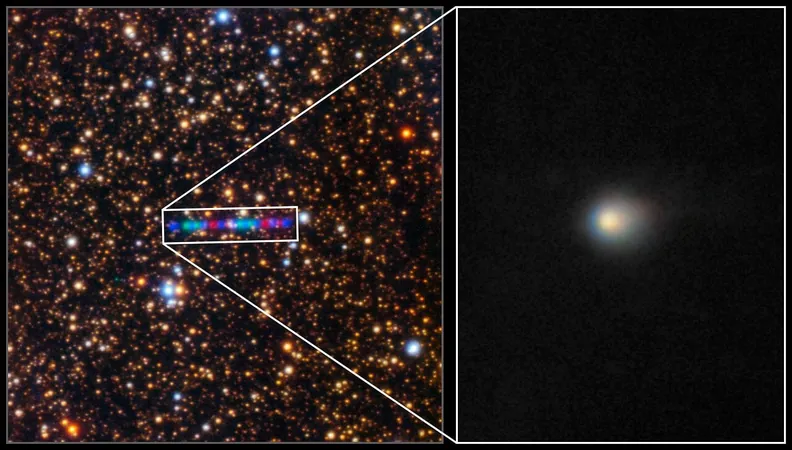
Unlocking the Secrets of Interstellar Comet 3I/ATLAS: A Cosmic Spectacle Unveiled!
2025-07-18
Author: Sarah
A Celestial Marvel Approaches
The powerful Gemini North telescope, perched atop Mauna Kea, Hawai‘i, has turned its gaze to the thrilling interstellar comet 3I/ATLAS as it rushes toward its closest approach to the Sun. Astronomers are now getting breathtaking views of this cosmic wanderer, revealing its features in stunning detail.
A Dusty Coma Emerges
As 3I/ATLAS nears the inner solar system, the images captured show a magnificent dusty coma forming around its nucleus. The vibrant colors are a result of observations made using Gemini's Multi-Object Spectrograph (GMOS-N), allowing scientists to examine the comet across various spectral wavelengths.
Navigating Stargazers’ Challenges
"3I/ATLAS is currently traversing dense regions of star fields near the heart of the galaxy in Sagittarius," explains Karen Meech from the University of Hawai‘i Institute for Astronomy. This makes it tricky for astronomers to find clear observation windows without the interference of bright stars.
A Rich History in the Making
The stunning merged images reveal a distinctive teardrop-shaped coma, a hallmark of comets. As with most astronomical feats, securing observation time is competitive. As Meech states, "Gemini operates on a queue system, effectively maximizing observation efficiency even amidst challenges like bad weather." The stellar staff ensured the telescope's capabilities were fully utilized to study this celestial gem.
The Comet’s Intriguing Composition
3I/ATLAS exhibits a reddish hue, similar to other known Kuiper Belt Objects (KBOs). Current assessments suggest that this alien visitor's nucleus could range from under a kilometer to over 20 kilometers wide—significantly larger than its interstellar counterparts 1I/‘Oumuamua and 2I/Borisov.
What Lies Ahead?
Positioned just under 4 Astronomical Units (AU) from the Sun, 3I/ATLAS is set to reach its perihelion at 1.356 AU on October 29, followed by a close encounter with Earth on December 19 at a distance of 1.8 AU. Mars, however, will have the VIP view, receiving the comet at a mere 0.2 AU on October 3.
An Ancient Voyager?
Discovered by the ATLAS program on July 1, 2025, 3I/ATLAS has exhibited unique behavior that hints at its ancient origins, potentially predating our solar system by billions of years.
What’s Next for 3I/ATLAS?
As astronomers eagerly prepare for more observations in the upcoming months, including planned imaging by the Hubble Space Telescope, the excitement surrounding 3I/ATLAS only grows. With each passing moment, this interstellar traveler is not just brightening but also captivating the imaginations of sky watchers around the world.
Capture the Cosmic Beauties!
As the comet navigates through the star-laden fields of Ophiuchus, it promises to offer remarkable photographic opportunities for both amateur and professional astronomers alike. Don’t miss your chance to witness this awe-inspiring cosmic event!


 Brasil (PT)
Brasil (PT)
 Canada (EN)
Canada (EN)
 Chile (ES)
Chile (ES)
 Česko (CS)
Česko (CS)
 대한민국 (KO)
대한민국 (KO)
 España (ES)
España (ES)
 France (FR)
France (FR)
 Hong Kong (EN)
Hong Kong (EN)
 Italia (IT)
Italia (IT)
 日本 (JA)
日本 (JA)
 Magyarország (HU)
Magyarország (HU)
 Norge (NO)
Norge (NO)
 Polska (PL)
Polska (PL)
 Schweiz (DE)
Schweiz (DE)
 Singapore (EN)
Singapore (EN)
 Sverige (SV)
Sverige (SV)
 Suomi (FI)
Suomi (FI)
 Türkiye (TR)
Türkiye (TR)
 الإمارات العربية المتحدة (AR)
الإمارات العربية المتحدة (AR)